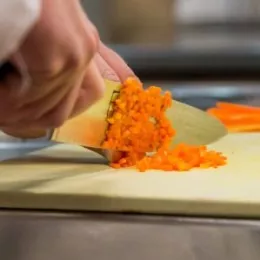On Sunday, March 24, 2019, the International Culinary Center hosted a jam-packed day of discussions and networking for pastry professionals at the second Pastry Plus Conference. Pastry Plus provides a unique opportunity to connect the innovative minds of pastry professionals to meet and discuss the changing landscape of the industry. As a community, pastry chefs, sous chefs, line cooks, bakers and pastry business owners address the evolving workplace, learn about industry innovations and expand the sphere of the modern pastry chef.
Our partner for Pastry Plus, Callebaut, hosted a breakout session on Understanding Your Chocolate with Russ Thayer (Callebaut Chef) and Rocco Lugrine (East Coast Technical Advisor–Brand Awareness for Callebaut).
In this session, they broke down everything from chocolate terms to agriculture, production and applications of various types of chocolates for confections, going in depth on how to use chocolate in the best applications possible. Below, get a peek at what we learned and develop your understanding of the vast world of chocolate!
TERMS
There are a lot of terms that describe the quality of chocolate. In the professional world, you’ll often hear couverture, single origin or plantation. Couverture is a widely recognized term in Europe, but in the USA, it is less commonly used—by definition it must contain 35% cacao, including at least 31% cocoa butter. This produces a more fluid melt, which can create thinner applications. (Note: couverture can only be applied to milk and dark chocolates since white chocolate has no cacao solids present). Single origin is pretty self explanatory, although commonly used as a buzz word nowadays—this means that the chocolate is from a single point of origin (eg. country, or geographic region). The various environments produce distinct cacao bean flavor and properties. Finally, getting even more specific, plantation chocolate indicates the beans are from a single farm.
Consumers most often recognize the terms semi-sweet and bitter-sweet in dark chocolates. While these terms have a broad range, semi-sweet will often mean that it has 50-60% cocoa liquor, while bitter-sweet usually means that it has above 60% cocoa liquor.
Cocoa liquor is a semisolid mixture of cocoa butter (the edible cocoa fat extracted from cocoa beans) and cocoa solids. Despite its name, cocoa liquor does not contain any alcohol.
While this is not an exhaustive list—really, there are hundreds of terms that describe chocolate—this is some of the most common language to know.
WORKABILITY
 Workability generally refers to the viscosity of the melted chocolate, which comes from the ingredient composition. For instance, as you increase the fat percentage, the fluidity of the chocolate will also increase, which will change the overall workability. If a chocolate has high fluidity, it will be very liquid when melted, and produce a thinner coat when the chocolate sets. Higher fluidity is ideal for molding, decorations and dessert preparations that need a more firm texture.
Workability generally refers to the viscosity of the melted chocolate, which comes from the ingredient composition. For instance, as you increase the fat percentage, the fluidity of the chocolate will also increase, which will change the overall workability. If a chocolate has high fluidity, it will be very liquid when melted, and produce a thinner coat when the chocolate sets. Higher fluidity is ideal for molding, decorations and dessert preparations that need a more firm texture.
Simply put, if melted chocolate is too thick, it can’t be used for molded chocolates, like a bonbon. Overall, it’s important to know that workability is a factor when determining the application of the chocolate.
TEXTURE OF FINISHED PRODUCT
 Cacao percentage, which indicates the total amount of cocoa liquor, is often used to describe most chocolates. Chocolate has two main components—cocoa solids (where the flavor comes from) and cocoa butter (where the rich texture comes from). As you increase cocoa solid percentage, the chocolate becomes less sweet and gives a more pronounced texture.
Cacao percentage, which indicates the total amount of cocoa liquor, is often used to describe most chocolates. Chocolate has two main components—cocoa solids (where the flavor comes from) and cocoa butter (where the rich texture comes from). As you increase cocoa solid percentage, the chocolate becomes less sweet and gives a more pronounced texture.
In the Pastry Plus Session with Callebaut, the audience was given 3 different mousses to try that used 3 different dark chocolates. Each one had increasing amounts of cocoa butter and cocoa solids, which made each mousse thicker and firmer progressively.The goal was to recognize the impact of even the slightest changes to the percentage of cocoa composition on the final finished texture.
TASTE
 As cacao percentage increases, chocolate will have a stronger flavor and contain less sugar, thus becoming less sweet. However, taste is also controlled by the bean: varietal type, the geography, the climate and the processing methods, which includes fermentation and the roasting (time, temperature, and style of roasting). Much like how terroir affects a bottle of wine, the land where the cacao beans are grown and how the producer chooses to produce their beans will also impact the final dessert that you put onto a menu.
As cacao percentage increases, chocolate will have a stronger flavor and contain less sugar, thus becoming less sweet. However, taste is also controlled by the bean: varietal type, the geography, the climate and the processing methods, which includes fermentation and the roasting (time, temperature, and style of roasting). Much like how terroir affects a bottle of wine, the land where the cacao beans are grown and how the producer chooses to produce their beans will also impact the final dessert that you put onto a menu.
When chocolate is refined, the particles of the beans change. Fine particles will give a long lasting taste and smoother mouth feel, while the opposite can be said for large particles. Conching the chocolate is a technique that processes the chocolate mixture through rollers and reduces the cocoa solid and sugar sizes. It also generates heat which causes additional chemical reactions within chocolate. If you conch the chocolate for too long and vary different temperatures, the taste will change from fruity and acidic to toasted and milky.

Want to learn more about Callebaut’s array of chocolate products? Visit Callebaut’s website to get started!
Explore the bean-to-bar chocolate lab at ICE.
This blog post was originally published by the International Culinary Center (ICC), founded as The French Culinary Institute (FCI). In 2020, ICE and ICC came together on one strong and dynamic national platform at ICE's campuses in New York City and Los Angeles. Explore your culinary education where the legacy lives on.
Additional Resources & Sources:
Callebaut, Barry. “Understanding Your Chocolate.” Pastry Plus Conference. Pastry Plus, 24 Mar. 2019, New York, New York.
“Conching and Refining.” Chocolate Alchemy.
Medrich, Alice. “The Dark Side of Chocolate – How-To.” FineCooking, 19 Apr. 2017.
Rees, Nicole. “Chocolate vs. Cocoa Powder – Article.” FineCooking, 19 Apr. 2017.



